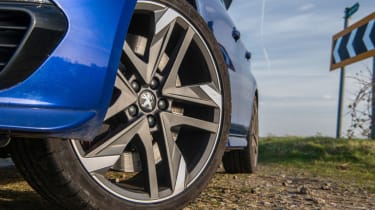Peugeot 308 GTi by Peugeot Sport review (2014-2021) – ride and handling
An exciting hot hatch with typical French quirks
Peugeot Sport has produced a pair of excellent drivers’ cars of late, the RCZ-R and 208 GTi by Peugeot Sport. For the most part the 308 GTi contributes to its winning streak, even if it isn’t quite as magical as its forbearers.
Over rough ground the 308 GTi feels stiff and fidgety, however as the speed increases it seems to find a rhythm and settle down. The ride is matched by taut body control that keeps the 308 synchronised with the bigger road undulations. It doesn’t deal with smaller crests and rough sections with the same irreproachable competancy, though. However, there’s enough composure for the 308 GTi to maintain a great cross-country pace.
The GTi retains the standard 308’s basic suspension arrangement, using a strut front axle and a torsion beam rear end. Changes to the GTi come in the form of spring, damper, toe, camber and roll stiffness settings. Peugeot Sport has increased the front spring rates by 60 per cent compared to the less sporting 308 GT, and the rears are 100 per cent stiffer. The rear axle bushes are is also firmer and the body sits 11mm lower.
Despite those revised suspension settings Peugeot Sport says the 308 GTi is less aggressive than the 208 GTi by Peugeot Sport, which feels pretty harsh on a really demanding road surface but is incredibly rewarding on smoother roads.
More reviews
Indeed, the 308 GTi does feel less aggressive. Driven in a brisk but relaxed manner it can almost feel docile and doesn’t exhibit the same bite as its little brother.
Push a little harder and the chassis, just like the engine, begins to shows its teeth. It feels alert when you turn into a corner and the body stays flat. The small steering wheel can often cause you to make bigger and quicker movements than you might often want, but the 308’s front axle always obeys.
Off the throttle there’s enough movement from the rear axle to help guide the nose towards an apex, too. If your actions remain calm and measured it doesn’t translate to oversteer, just enough rotation for the 308 to feel suitably agile for a hot hatch.
The limited slip differential really helps pull the 308 GTi through and out of a corner. However, as mentioned before, traction can be an issue under full power. Exiting tight corners requires careful application of the throttle but faster corners are less of an issue and you can revel in the assistance from the LSD.
The 308 GTi’s front axle is equipped with 380mm ventilated discs mounted on aluminum carriers that are pinched by four-piston brake calipers. It’s a very serious set up, but not one that feels as impressive as it looks. The brakes are good and withstand significant use, but they don’t dominate the way the car drives. Instead they feel natural and progressive.
As involving as the 308 GTi is, it just isn’t quite as malleable or as engaging as the other cars that Peugeot Sport has created. It’s also not as precise or as thrilling as the exceptional Renault Sport Megane 275, but then again not many cars are. The 308 GTi strikes a balance between usability and fun that not many of its rivals can achieve, the almost inert Golf GTI for one.




